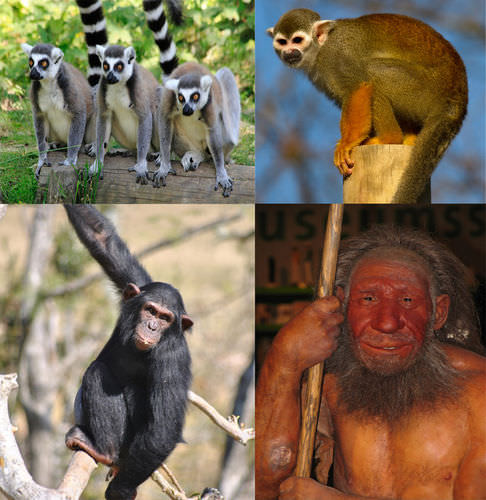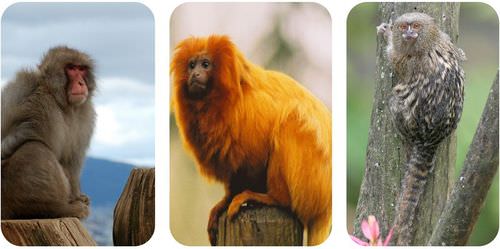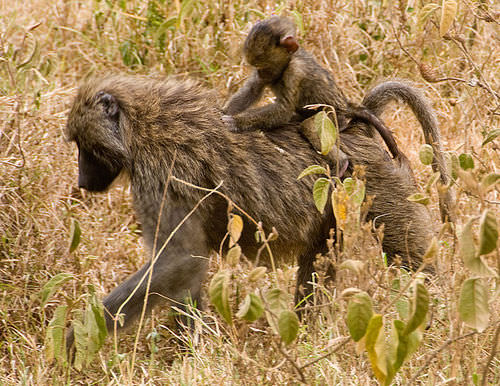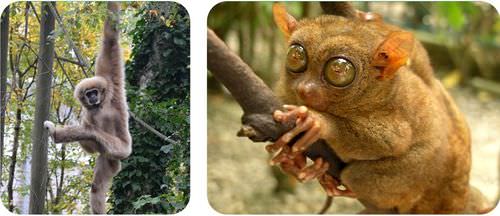10.24: Primates
- Page ID
- 14177

How are the monkey and the girl alike?
Both are intelligent and can learn new things quickly. They both like to play. And they are both primates.
What Are Primates?
If primates are mammals, what makes them seem so different from most mammals? Primates, including humans, have several unique features. Some adaptations give primates advantages that allow them to live in certain habitats, such as in trees. Other features have allowed them to adapt to complex social and cultural situations.
Primates are mostly omnivorous, meaning many primate species eat both plant and animal material. The order contains all of the species commonly related to lemurs, monkeys, and apes. The order also includes humans (Figure below).

Key features of primates include:
- Five fingers, known as pentadactyl.
- Several types of teeth.
- Certain eye orbit characteristics, such as a postorbital bar, or a bone that runs around the eye socket.
- An opposable thumb, a finger that allows a grip that can hold objects.
What's the difference between monkeys and apes? The easiest way to distinguish monkeys from the other primates is to look for a tail. Most monkey species have tails, but no apes or humans do. Monkeys are much more like other mammals than apes and humans are.
Big Brains
In intelligent mammals, such as primates, the cerebrum is larger compared to the rest of the brain. A larger cerebrum allows primates to develop higher levels of intelligence. Primates have the ability to learn new behaviors. They also engage in complex social interactions, such as fighting and play.
Social Relationships
Old World species, such as apes and some monkeys (Figure above and Figure below), tend to have significant size differences between the sexes. This is known as sexual dimorphism. Males tend to be slightly more than twice as heavy as females. This dimorphism may have evolved when one male had to defend many females. Old World generally refers to monkeys of Africa and Asia. New World refers to monkeys of the Americas.
New World species, including tamarins (squirrel-sized monkeys) and marmosets (very small primitive monkeys) (Figure below), form pair bonds, which is a partnership between a mating pair that lasts at least one season. The pair cooperatively raise the young and generally do not show a significant size difference between the sexes. Old World monkeys do not tend to form monogamous relationships.

Where Do Non-human Primates Live?
Non-human primates live mostly in Central and South America, Africa, and South Asia. Since primates evolved from animals living in trees, many modern species still live mostly in trees. Other species live on land most of the time, such as baboons (Figure below) and the Patas monkey. Only a few species live on land all of the time, such as the gelada and humans.

Primates live in a diverse number of forested habitats, including rain forests, mangrove forests and mountain forests to altitudes of over 9,800 feet. The combination of opposable thumbs, short fingernails, and long, inward-closing fingers has allowed some species to develop the ability to move by swinging their arms from one branch to another (Figure below). Another feature for climbing are expanded finger-like parts, such as those in tarsiers, which improve grasping (Figure below).
A few species, such as the proboscis monkey, De Brazza’s monkey, and Allen’s swamp monkey, evolved webbed fingers so they can swim and live in swamps and aquatic habitats. Some species, such as the rhesus macaque and the Hanuman langur, can even live in cities by eating human garbage.

Summary
- Features of primates include five fingers, several types of teeth, an opposable thumb, and a large brain.
- Primates live in a variety of places, including trees, swamps, and on land.
Explore More
Use the resources below to answer the questions that follow.
Explore More I
- Primate Classification at http://www.youtube.com/watch?v=Zd7syFmutjU (2:15)
- How do primates differ from other animals?
- How do prosimians differ from monkeys?
- How do Old World monkeys differ from New World monkeys?
- How do apes differ from monkeys?
Explore More II
- Ring-Tailed Lemurs at http://kids.nationalgeographic.com/kids/animals/creaturefeature/ring-tailed-lemur/
- Why are lemurs endangered?
- Where do lemurs live?
- How do lemurs mark their territory?
Review
- What's the difference between monkeys and apes?
- What is an opposable thumb?
- What is the significance of a large cerebrum?
- What is meant by pentadactyl?

